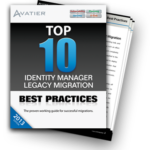September 11, 2013 • Garrett Garitano
How to Apply Automation to Your HIPAA Compliance Checklist
Automate your HIPAA compliance checklist. Protecting patient privacy rests at the heart of HIPAA regulations. The regulatory requirements address administrative processes, facilities security and technical protocols. With all of the moving parts around managing HIPAA regulatory mandates, what can you do to make things simpler and more efficient for your organization? Automate as many operations as […]

Protecting patient privacy rests at the heart of HIPAA regulations. The regulatory requirements address administrative processes, facilities security and technical protocols. With all of the moving parts around managing HIPAA regulatory mandates, what can you do to make things simpler and more efficient for your organization? Automate as many operations as you can on your HIPAA compliance checklist.
HIPAA security requirements center around seven key areas that should serve as the foundation of your compliance checklist:
Unique User Identification — Each and every user accessing your networks must be assigned a unique moniker with a sufficiently complex password. This activity must be tracked at a user account or user identity level.
- Emergency Access — In case of emergency, have specified procedures in place for retrieving and securing electronic data. In the instance that a medical practitioner loses or forgets a password, self-service password reset capabilities empower personnel to quickly and securely reset their passwords and access important patient health information during the critical treatment window. It should also allow for two factor authentication for ensured identity access management protection.
- Automatic Log-Off and Workflow‐ Once a network access session has reached a predetermined time of inactivity, the system should automatically log off the user. This prevents unauthorized users from hijacking an abandoned but active session. The user account’s access to every other system on the network should also be denied through workflow.
- Encryption and Decryption — To preserve data security with an added layer of protection, implement a mechanism to encrypt and decrypt confidential patient data where appropriate. Additionally, capture the identity of every user account with access including administrators.
- Audit Controls — Software featuring prebuilt compliance management tools through recording, examining and generating reports on key areas of examination significantly streamline the audit process. They also capture the identity of every user account generating reports including administrators; super users and chief executives so can have absolute confidence in your audit controls.
- ePHI Integrity — Digitized patient health information (PHI) offers the opportunity to streamline healthcare operations and improve the overall quality of care; however, your automated HIPAA compliance management tool should include features that assure your access management and access governance audit controls to prevent unauthorized access and detect inappropriate access to electronic records.
- Authentication — HIPAA regulations mandate that health care organizations implement identity access management protocols to verify both the identity of the person seeking network access, apply their access privileges based on their role, groups and organizations, and capture their activities to protect patient health information privacy.
The key to effectively protecting patient health information privacy and managing HIPAA compliance with IT operations is automation. The right identity management, access management, and access governance software makes all the difference — built in HIPAA compliance automation tools and audit controls simplify both the HIPAA reviews while improving data security to better ensure patient privacy.
The digitization of PHI medical records is an important advancement in both operational efficiency and quality of care, and the right identity and access management software featuring user provisioning and built-in HIPAA compliance tools ensures that these benefits are realized without compromising patient privacy.
Each and every one of us is entitled to confidentiality around our personal, private PHI medical records. We also all benefit from our medical practitioners having full purview into our health history so that they can recommend the best possible treatment options and quality of care.
Delivering on your HIPAA compliance checklist through software automation and workflow, delivers the best possible information security protection to your patients and while improving healthcare IT operations, because manual maintenance is no longer required for these tasks. HIPAA compliance management automation liberates your IT staff to do what they do best with regards to these regulatory standards — ensure successful operations, provide information security, streamline reviews and hopefully continuously improve throughout the process.
Watch the Avatier Identity Management Megatrends Driving the Future Video
Ryan Ward, Chief Innovation Officer and Chief Information Security Officer at Avatier talks about how the next step in the evolution of identity and access management can have a dramatic influence in streamlining IT department processes.
Get the Top 10 Identity Manager Migration Best Practices Workbook
 Start your migration from legacy software with the Top 10 Identity Manager Migration Best Practices Workbook. Use this workbook to think through your information security risk before you transition to next generation identity manager software.
Start your migration from legacy software with the Top 10 Identity Manager Migration Best Practices Workbook. Use this workbook to think through your information security risk before you transition to next generation identity manager software.









